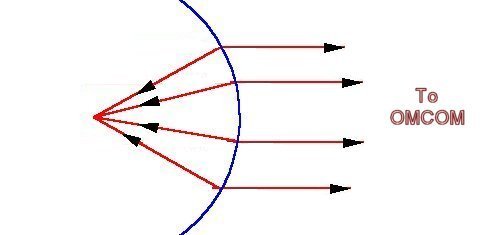Lens-less cameras, revisited
As a cornerstone of Rome's Revolution, I have mentioned the star-probes acting as a lens-less camera on more than one occasion. In our real world, there are several instances of less-less cameras already in use today.
Bell Labs introduced a lens-less camera that can not only resolve an image but can actually render it in color. However, the camera is not real-time and only uses a single pixel element scanning the static image to be rendered time and time again using different filters. This type of camera would not be very useful in "seeing" a Stareater in action.
The lens-less camera invented at Duke is closer to that of the star-probes. According to the article:
Here is a picture of a concave arrangement of star-probes creating a virtual focal point on light waves:

The star-probes are the inverse of a lens. Instead of reflecting and focusing the light waves upon a single point, they only collect the light waves from the single point and transmit them back to OMCOM for compiling into a coherent picture.
Tomorrow: your first glimpse at an actual star-probe!
Bell Labs introduced a lens-less camera that can not only resolve an image but can actually render it in color. However, the camera is not real-time and only uses a single pixel element scanning the static image to be rendered time and time again using different filters. This type of camera would not be very useful in "seeing" a Stareater in action.
The lens-less camera invented at Duke is closer to that of the star-probes. According to the article:
The imaging system developed by graduate student John Hunt and colleagues at Duke University in North Carolina has no lens and instead combines a metamaterial mask or aperture and complicated mathematics to generate an image of a scene.This is the method I invoked for OMCOM. The star-probes formed along a concave geometry and used a small collection tube to guarantee that the photons they captured were only seen along the desired vector. The rest was pure mathematics and as a super-computer with not much else to do, OMCOM was completely up to the task of rendering the images in perfect focus in real time.
Here is a picture of a concave arrangement of star-probes creating a virtual focal point on light waves:

The star-probes are the inverse of a lens. Instead of reflecting and focusing the light waves upon a single point, they only collect the light waves from the single point and transmit them back to OMCOM for compiling into a coherent picture.
Tomorrow: your first glimpse at an actual star-probe!
Published on February 18, 2014 05:47
•
Tags:
action, adventure, ftl, science-fiction, space-travel, vuduri
No comments have been added yet.
Tales of the Vuduri
Tidbits and insights into the 35th century world of the Vuduri.
- Michael Brachman's profile
- 21 followers



